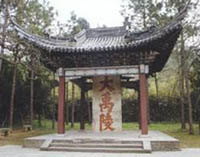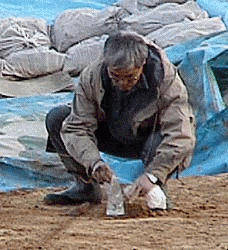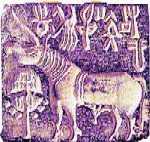Difficulties
Antiquity FrenzyErrors in history are bad enough, but intentional misrepresentations in history are truly deplorable. They are also very common, and they are especially common where governments or nations are involved. In Asia, national involvement often takes the form of claiming a higher antiquity than that culture actually has. Asian nations are not only in rivalry with each other for claims on territory, they are in rivalry with Mesopotamia and Egypt for the title of First Civilization. For them, antiquity fraud has become a policy; a way of life. The race to get ahead in that way of life produces Antiquity Frenzy.
Here are three examples, from the late and unlamented 20th century.
Antiquity frenzy is nothing new in China. It was already a key element in the unification rhetoric that preceded the forced unification of the Warring States, by Chin in 0221.
Tswei Shu in the 18c, and Gu Jye-gang again in the 20c, detected in the Warring States and Han texts the process by which the eventual list of ancient mythical emperors was "built up in reverse," the earlier figures on that list first appearing in increasingly later texts. Our study of the dates of the classical sources confirms the truth of this observation, and shows in detail the stages by which the antiquity idea, and the idea that "China" goes back recognizably to the early Neolithic, took hold over the course of the classical period.
In 1995, it was noticed that Western scholarship considered the dates of the supposed early dynasties, Sya and Shang to be uncertain, with Sya being especially an object of suspicion, despite the fact that the tomb of Yw, the founder of Sya, was extant not only at one, but at many locations in China. The Chinese government budgeted millions for a five-year Sandai or Three Dynasties project, with the intention of giving these dates, and these dynasties, a firm scientific foundation. Chinese scientists who felt that such precision could not be reached were dropped from the project. Radiocarbon evidence was fudged or "wiggled." Archaeological sites were tenuously identified with certain supposed historical periods, the classic circular error. Still, it was claimed that during the five-year process, "all voices would be heard."
A showdown of sorts occurred at an Association for Asian Studies panel in 1998, where representatives of the Chinese government were featured along with scholars critical of Sandai methods and the results. It there emerged that some of the native workers felt they had been pressured into doing "bad science." As for the critics, one American scholar was pressured to moderate the remarks it was known he planned to make, and one Chinese scholar was openly denounced by the government side as a "traitor."
Such was the tenor of things. As the Project reached its predicable end, Bruce Gilley reported to the general public in the Far Eastern Economic Review (20 July 2000) that the assurances that "all voices would be heard" were ill founded. International scholars had been excluded from the Project as "the biggest doubters of the Sya Dynasty," and the reservations of native participants "have been silenced through a series of 'work report' meetings, according to officials involved." Another critical report by Erik Eckholm appeared in the New York Times for 10 Nov 2000. It included a quote from Edward Shaughnessy of the University of Chicago, who noted "There's a chauvinistic desire to push the historical record back into the third millennium BC, putting China on a par with Egypt. It's much more a political and a nationalistic urge than a scholarly one."
This drew disingenuous defenses from some Sandai-associated American scholars, not printed by the Times but circulated among the scholarly community.
"Is it somehow inherently suspect for the Chinese to research their own past?"
"The Chinese are justifiably proud of their ancient civilization and their impressive historical achievements,"
"After all, one does have to print some date on museum labels."
To answer only the last of these: No, one doesn't. One can print a circa, one can print a span, one can print an era. It doesn't have to be exactly the year 01046.
Said an archaeologist, reporting on a dig in Vietnam where Chinese colleagues identified every new shard as proof that the Yellow Emperor had originally held sway over that territory, territory which happened to be associated with Vietnamese offshore oil deposits, "I was trained as a scientist. I don't know how to deal with this stuff." Where one side brings pressure that the other side is not schooled to resist, you get a steamroller. What we have in this area is an interpretational steamroller. A steamroller with more than two thousand years of experience in cooking data. A high-stakes steamroller.
Japan is a small nation, with a short history if by "history" we mean something externally attested. The internal tradition is that Japanese sovereignty descended from the skies at a much earlier date. This is the national myth. It involves the divinity of the Japanese Emperor. It is fervently credited by otherwise educated Japanese persons. This creates a public attitude that is very receptive to archaeological discoveries tending to show that the presence of humankind in the Japanese islands goes back a long way, especially if the result puts Japan on a par with the more widely recognized cradle of civilization: Mesopotamia.
Results tending in this direction were increasingly reported by the late 20th century Japanese press, and were welcomed by a delighted public. One archaeologist in particular, Fujimura Shin'ichi, was said by his colleagues to possess "divine hands" because of has uncanny instinct for uncovering evidences of early human habitation. His high-profile career began in 1981 with his discovery of pottery remains dating back 40,000 years (the previously record was 30,000 years). He had since then been involved in some 180 digs, artifacts from which constitute a large part of the scholarly record of the Japanese Paleolithic, and had reached a position as Deputy Director of the Tohoku Paleolithic Institute. This year, following work at the important site of Soshin Fudozaka, he had found at another northern Japan site, Kamitakamori, stone artifacts in a stratification context which would make them 600,000 years old - among the oldest Paleolithic objects in Japan, or in the world.
In brief: The objects were from his own collection. He had buried them there himself.
This was an especially insidious type of fakery, in that the objects themselves were genuine, and so capable of withstanding normal physical scrutiny. The fakery was in recontexting them - placing them in an older stratum of earth than the one from which they had been taken.
Photographs of Fujimura doing this - digging a hole, placing the artifacts in it, and tamping down the earth again with his boot - ran on the front page of the 5 November 2000 Sunday Mainichi Shimbun. They drew a confession and an offer to resign. In his televised apology, Fujimura blamed his imposture on the burden of "having to find ever older sites." What that acceptance of personal responsibility diverted attention from was the cultural agenda which had contributed a large share of the pressure.
An almost instantaneous official response, within hours of the public confession, was to remove from museum display all Paleolithic objects associated with Fujimura digs. A second official response, the day after the public confession, was to cancel a substantial part of the Tohoku Institute's funding. By the third day, there was talk of rewriting the officially-approved school history texts, which had already featured the Kamitakamori site. The longer-term scholarly consequence will be an agonizing reappraisal of the whole picture of the Japanese Paleolithic, which at one stroke has had much of its physical evidence placed in doubt. It has already been suggested that its earliest age may have to be revised downward from 600,000 to 30,000 years.
Which was exactly where Fujimura found it at the beginning of his career.
One of the pinnacles of European intellectual achievement was the discovery of the Indo-European language family, a discovery stimulated by 18c European studies of Sanskrit. The historical implication is that the Vedic civilization of India was brought there by migrants from the northwest who possessed the horse and war chariot, and practiced a religion centering on fire sacrifices. India, like Japan, is thus a country whose classical high culture is imported, not indigenous. This can lead to a psychologically precarious cultural identity. Such identities are highly vulnerable to culture pressure.
One notable pre-Aryan monument in India is the enigmatic Harappan (or Indus Valley) civilization, which possessed an urban culture, and perhaps also a proto-writing system. After its decline, in the early 02m, cities vanish from the Indian archaeological record, to reappear only centuries later. Modern Hindu nationalists who are uncomfortable with the Indian past as presently understood have looked to Harappa for a different national history. If it could be shown that the Harappans possessed the horse, the Aryan scenario could be dismissed as a myth, and a foreign-invented myth at that. India would have its own linear identity as a culture.
In summer 1999, N S Rajaram, a well-known Hindu nationalist, and Natwar Jha, a provincial religious scholar, jointly claimed to have deciphered the Indus Valley script, and to have read from the inscribed seals of the Indus Valley culture an extensive native literature. In detail, their readings provided "missing links" with later Vedic culture, and made unnecessary the concept of a historical Aryan incursion. On the crucial detail of the horse (around which major Vedic rituals centered), they also offered as evidence a Harappan seal claimed to depict a horse. Seals recovered from Harappa often depict animals, but horses had not previously been noticed among them, and they are conspicuously absent from the iconography of the culture.
The most typical Harappan seal animal is a "unicorn bull."
Examination revealed that the Harappan "horse seal" was a computer enhancement (more precisely, a disenhancement) of a previously known unicorn-bull seal fragment; that the Rajaram/Jha decipherment was so permissive as to allow almost any meaning to be read from an original sequence of symbols; and that the supposed "Late Vedic Sanskrit" of the seals - found two thousand years before that language is considered to have existed - contains grammatically impossible forms.
An article exposing the fraud, by Vedicist Michael Witzel and comparative historian Steve Farmer, was the cover story Horseplay in Harappa in the Indian newsmagazine Frontline for 13 Oct 2000. Printed next to the Witzel/Farmer article was another, Hindutva and History, by Indian historian Romila Thapar, who noted the psychological dilemma for Hindu nationalists: "The definition of a Hindu as given by Savarkar was that India had to be his pitribhumi (ancestral land) and his punyabhumi (the ancestral land of his religion). A Hindu therefore could not be descended from alien invaders. Since Hindus sought a lineal descent from the Aryans, and a cultural heritage, the Aryans had to be indigenous."
Some responses to Witzel and Farmer reached the level of death threats. The Letters column in the next issue of Frontline included responses ranging from denunciatory ("Your intentions are clearly to undermine Indian society." A D Sudhindra) to cautious ("Rajaram's theory . . . does not seem to proceed from facts to conclusions," A Jacob Sahayam). Later letters expressed concern (I hope these wild claims do not form part of textbooks meant for our youth," M Paul Korath, MD; "India is now at a critical point in time because it is in the hands of dangerous reactionary forces who came to power by spreading hatred and with the promise of correcting certain alleged historical wrongs. If not countered in time, there is a great hazard of these forces spreading their tentacles further and providing training in bigotry through school textbooks. The first step in this direction is to twist history so that it is in agreement with or aids their fanatical ideology," Pramod Kumar).
The control of history is indeed the key question. Since the Harappan Fraud, under a reactionary Indian government, individual scholars and entire research institutes have been physically attacked. Where history threatens to diverge from national agendas, it is in peril from nations.
There is nothing strange about "history" serving chauvinistic ends. History probably began as tribal glorification, and it has kept that primary mandate into the modern period. That sort of glorification is part of building and maintaining a modern nation. But for someone attempting to find out what really happened, all this glorification is perverse. The history of "history" as a discipline is the history of attempts to break away from the glorification model, and to create a tradition of objective inquiry. The Antiquity Delusion is in perpetual conflict with that newer, and more precarious, tradition of inquiry.
Good luck to that tradition, as we enter what is shaping up to be a high-pressure century.
27 Feb 2004 / Contact The Project / Exit to History Page


